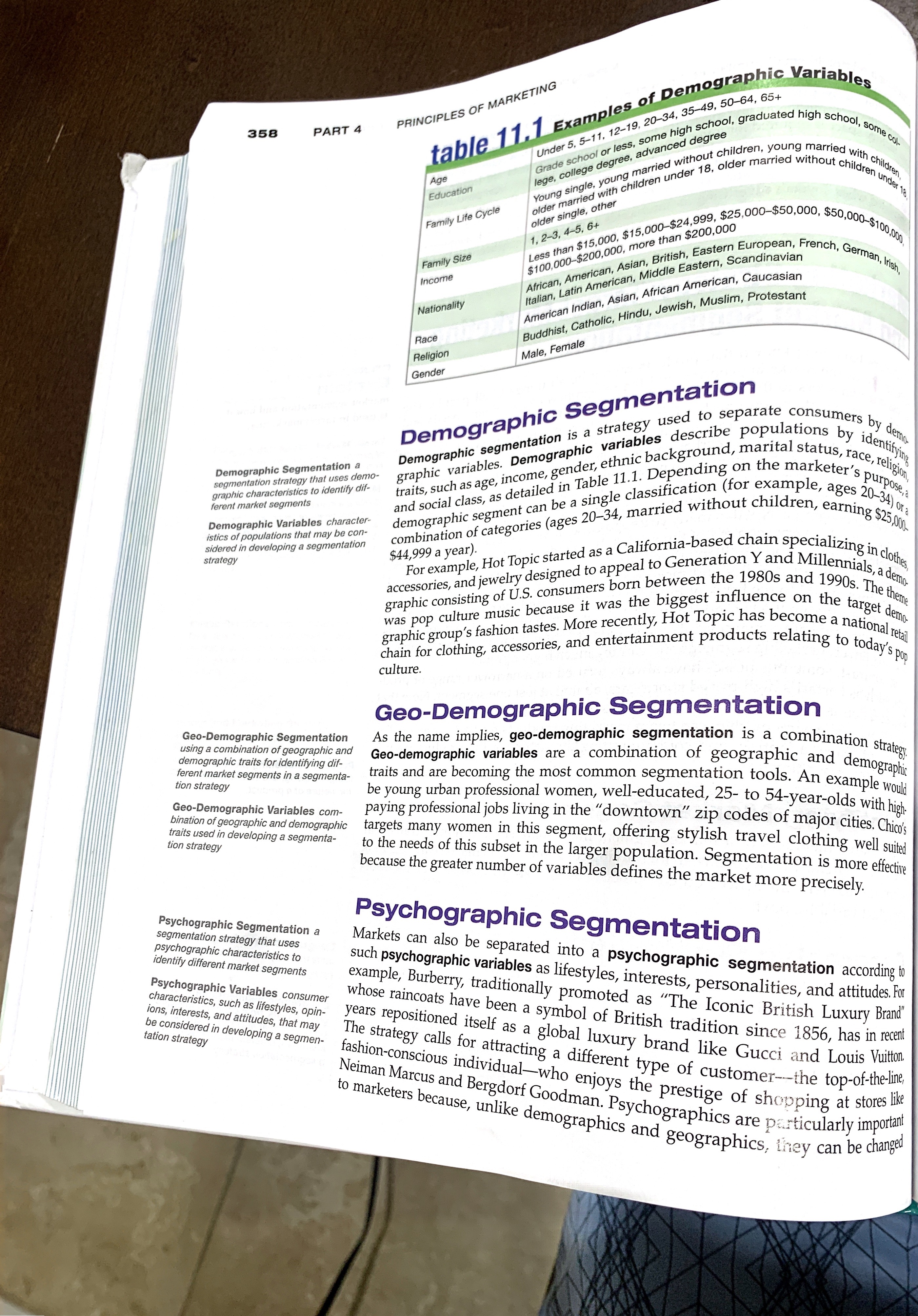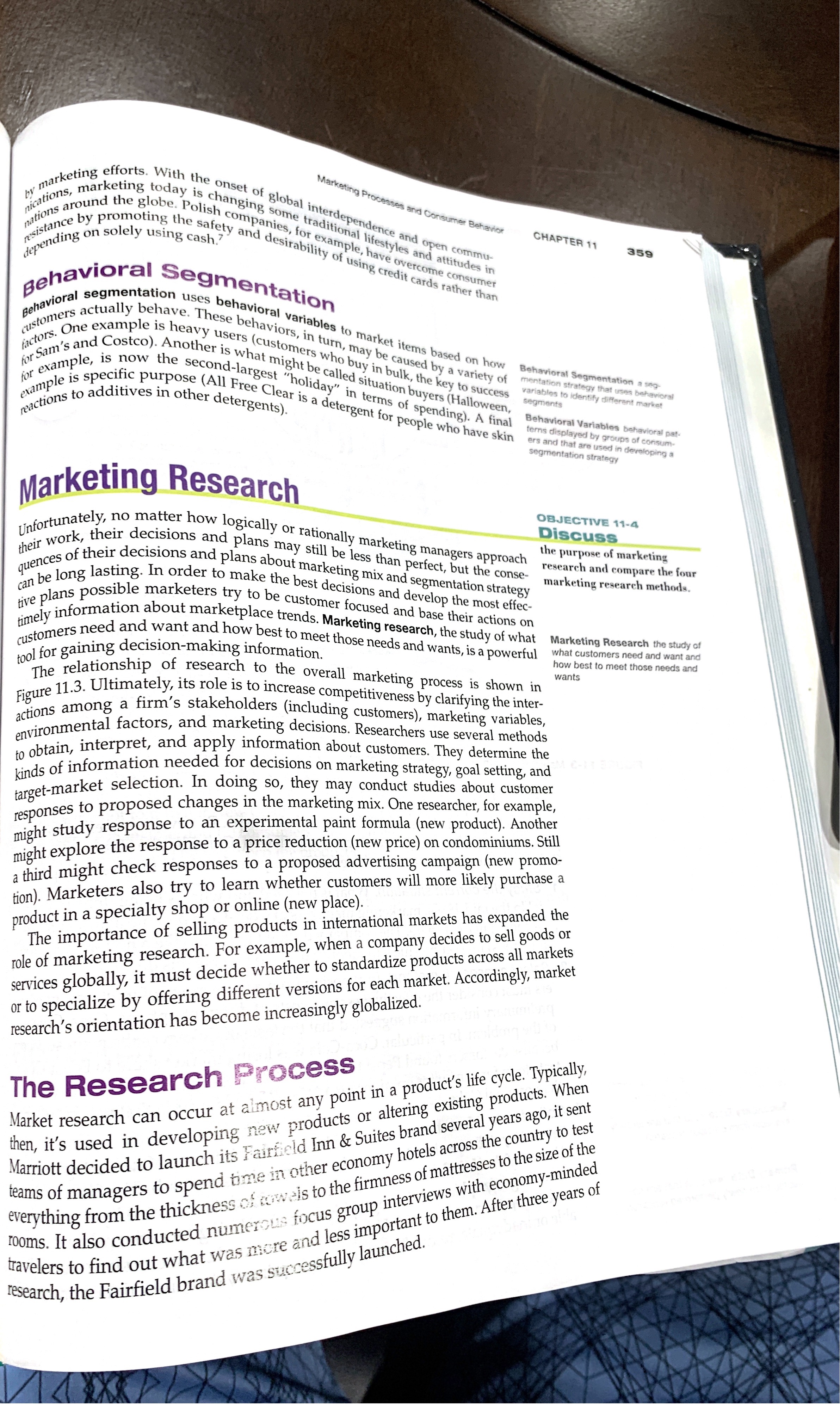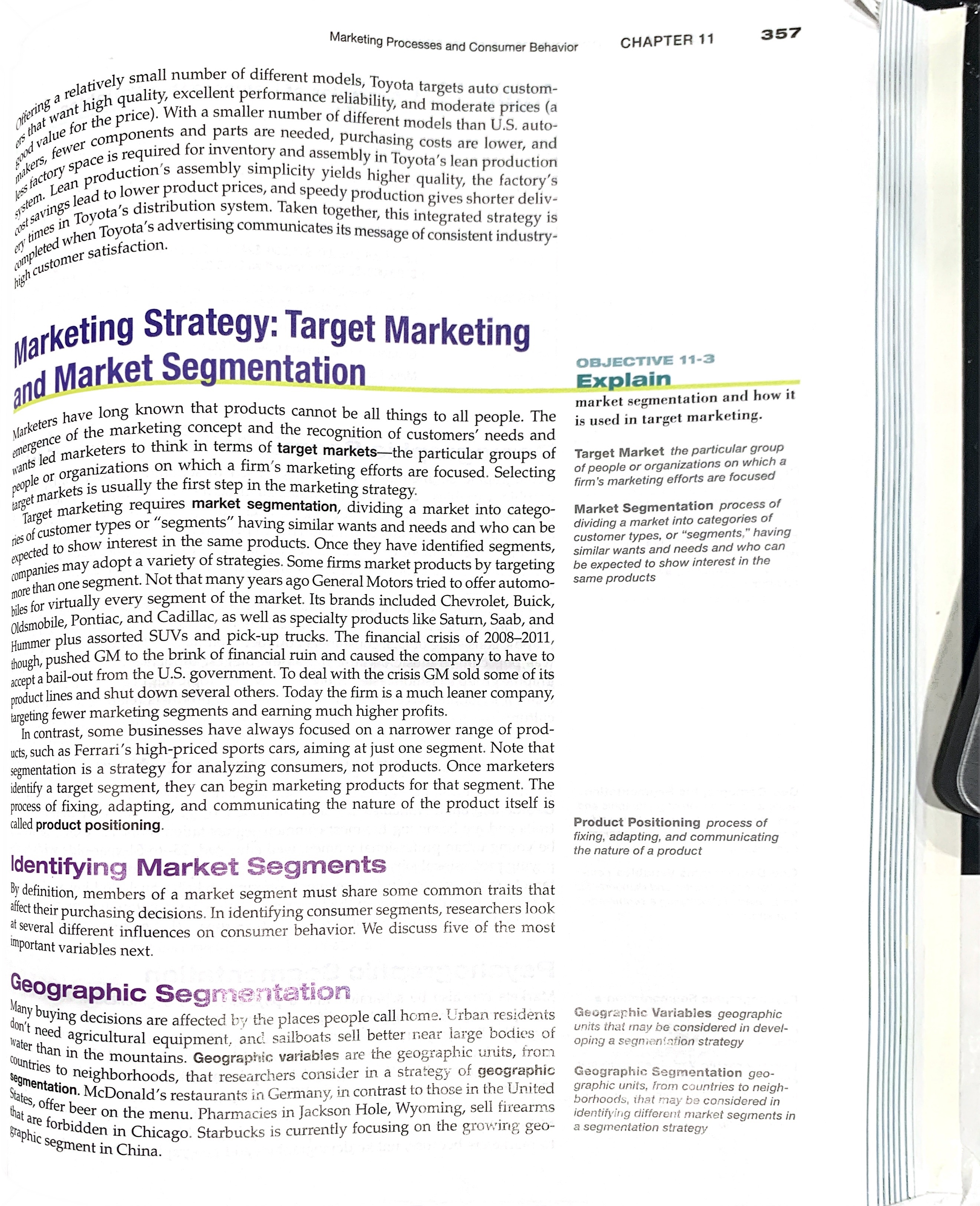It is the holiday season.Marketing budgets are being spent heavily to attract your attention to entice you to buy products.Chapter 11, specifically pages 357-359, lists and discusses 5 types of market segmentation.List each 5 and an example from CURRENT advertising - marketing that represents that strategy.
PRINCIPLES OF MARKETING 358 PART 4 table 11.1 Examples of Demographic Variables Under 5, 5-11. 12-19. 20-34, 35-49, 50-64, 65+ Grade school or less, some high school, graduated high school, some lege, college degree, advanced degree Age Education Young single, young married without children, young married with child elder married with children under 18, older married without children under Family Life Cycle older single, other 1 , 2 - 3 , 4-5, 6+ Family Size Less than $15.000, $15,000-$24,999, $25,000-$50,000, $50,000-$100,00 $100,000-$200,000, more than $200,000 Income African, American, Asian, British, Eastern European, French, German, Irigh Italian, Latin American, Middle Eastern, Scandinavian Nationality American Indian, Asian, African American, Caucasian Buddhist, Catholic, Hindu, Jewish, Muslim, Protestant Race Religion Male, Female Gender Demographic Segmentation emographic segmentation is a strategy used to separate consumers by dem Demographic Segmentation a segmentation strategy that uses demo- graphic variables. Demographic variables describe populations by identifi graphic characteristics to identify dif- wants, such as age, income, gender, ethnic background, marital status, race, religing ferent market segments and social class, as detailed in Table 11.1. Depending on the marketer's purpose Demographic Variables character- demographic segment can be a single classification (for example, ages 20-34) , istics of populations that may be con- sidered in developing a segmentation WillDination of categories (ages 20-34, married without children, earning $25,0(2 strategy $44,999 a year). for example, Hot Topic started as a California-based chain specializing in clothes accessories, and jewelry designed to appeal to Generation Y and Millennials, a demo graph phic consisting of U.S. consumers born between the 1980s and 1990s. The them was pop culture music because it was the biggest influence on the target deme graphic group's fashion tastes. More recently, Hot Topic has become a national reta culture. chain for clothing, accessories, and entertainment products relating to today's pop Geo-Demographic Segmentation Geo-Demographic Segmentation using a combination of geographic and demographic traits for identifying dif- As the name implies, geo-demographic segmentation is a combination strategy ferent market segments in a segmenta- tion strategy Geo-demographic variables are a combination of geographic and demographic traits and are becoming the most common segmentation tools. An example would Geo-Demographic Variables com- be young urban professional women, well-educated, 25- to 54-year-olds with high. bination of geographic and demographic traits used in developing a segmenta- paying professional jobs living in the "downtown" zip codes of major cities. Chico's ion strategy targets many women in this segment, offering stylish travel clothing well suited to the needs of this subset in the larger population. Segmentation is more effective because the greater number of variables defines the market more precisely. Psychographic Segmentation a segmentation strategy that uses Psychographic Segmentation psychographic characteristics to identify different market segments Markets can also be separated into a psychographic segmentation according to Psychographic Variables consumer such psychographic variables as lifestyles, interests, personalities, and attitudes. For characteristics, such as lifestyles, opin- ions, interests, and attitudes, that may example, Burberry, traditionally promoted as "The Iconic British Luxury Brand" be considered in developing a segment tation strategy whose raincoats have been a symbol of British tradition since 1856, has in recent years repositioned itself as a global luxury brand like Gucci and Louis Vuitton The strategy calls for attracting a different type of customer-the top-of-the-line, fashion-conscious individual-who enjoys the prestige of shopping at stores like Neiman Marcus and Bergdorf Goodman. Psychographics are particularly important to marketers because, unlike demographics and geographics, they can be changedMarketing Processes and Consumer Behavior marketing epting th the onset of global interdependence and open comes in bytions, marketing today, is changing some traditional lifestyles and attitude mer nicions around the globe. polish companies, for example, have overcome consusan CHAPTER 11 depending on solely using cash.? mallstance by promoting the safety and desirability of using credit cards rather 359 Behavioral Segmentation behavioral segmentation uses behavioral variables to market items based on how Bestomers actually behave. These behaviors, in turn, may be caused by a varieties cus ors. One example is heavy users (customers who buy in bulk, the key to success inSam's and Costco). Another is what might be called situation buyers (Halloween Behavioral Segmentation a sog- ample, is now the second-largest "holiday" in terms of spending). A final mentation strategy that uses behavioral variables to identify different market Sample is specific purpose (All Free Clear is a detergent for people who have Skins reactions to additives in other detergents). segments Behavioral Variables behavioral pat ferns displayed by groups of consum- ers and that are used in developing a segmentation strategy Marketing Research OBJECTIVE 11-4 Unfortunately, no matter how logically or rationally marketing managers approach Discuss their work, their decisions and plans may still be less than perfect, but the consen the purpose of marketing quences of their decisions and plans about marketing mix and segmentation strategy research and compare the four marketing research methods. can be long lasting. In order to make the best decisions and develop the most effect live plans possible marketers try to be customer focused and base their actions off timely information about marketplace trends. Marketing research, the study of what customers need and want and how best to meet those needs and wants, is a powerful Marketing Research the study of what customers need and want and tool for gaining decision-making information. how best to meet those needs and The relationship of research to the overall marketing process is shown in wants Figure 11.3. Ultimately, its role is to increase competitiveness by clarifying the inter- actions among a firm's stakeholders (including customers), marketing variables, environmental factors, and marketing decisions. Researchers use several methods to obtain, interpret, and apply information about customers. They determine the kinds of information needed for decisions on marketing strategy, goal setting, and target-market selection. In doing so, they may conduct studies about customer responses to proposed changes in the marketing mix. One researcher, for example, might study response to an experimental paint formula (new product). Another might explore the response to a price reduction (new price) on condominiums. Still a third might check responses to a proposed advertising campaign (new promo- tion). Marketers also try to learn whether customers will more likely purchase a product in a specialty shop or online (new place). The importance of selling products in international markets has expanded the role of marketing research. For example, when a company decides to sell goods or services globally, it must decide whether to standardize products across all markets or to specialize by offering different versions for each market. Accordingly, market research's orientation has become increasingly globalized. The Research Process Market research can occur at almost any point in a product's life cycle. Typically, then, it's used in developing new products or altering existing products. When Marriott decided to launch its Fairfield Inn & Suites brand several years ago, it sent teams of managers to spend time in other economy hotels across the country to test everything from the thickness of toweis to the firmness of mattresses to the size of the rooms. It also conducted numerous focus group interviews with economy-minded travelers to find out what was more and less important to them. After three years of research, the Fairfield brand was successfully launched.Marketing Processes and Consumer Behavior CHAPTER 11 357 foring a relatively small number of different models, Toyota targets auto custom (a offer at want high quagty, excellent performance reliability, and moderate prices (a of' "value for the price). With a smaller number of different models than U.S. auto 00ers, fewer components and parts are needed, purchasing costs are lower, and makectory space is required for inventory and assembly in Toyota's lean production lessem. Lean production's assembly simplicity yields higher quality, the factory sysleavings lead to lower product prices, and speedy production gives shorter delly tosrimes in Toyota's distribution system. Taken together, this integrated strategy 15 ely pleted when Toyota s advertising communicates its message of consistent industry high customer satisfaction. Marketing Strategy: Target Marketing and Market Segmentation OBJECTIVE 11-3 Explain market segmentation and how it marketers have long known that products cannot be all things to all people. The is used in target marketing. emergence of the marketing concept and the recognition of customers' needs and wants led marketers to think in terms of target markets-the particular groups of Target Market the particular group people or organizations on which a firm's marketing efforts are focused. Selecting of people or organizations on which a arget markets is usually the first step in the marketing strategy. firm's marketing efforts are focused Target marketing requires market segmentation, dividing a market into catego- Market Segmentation process of ies of customer types or "segments" having similar wants and needs and who can be dividing a market into categories of expected to show interest in the same products. Once they have identified segments, customer types, or "segments," having similar wants and needs and who can companies may adopt a variety of strategies. Some firms market products by targeting be expected to show interest in the more than one segment. Not that many years ago General Motors tried to offer automo- same products biles for virtually every segment of the market. Its brands included Chevrolet, Buick, Oldsmobile, Pontiac, and Cadillac, as well as specialty products like Saturn, Saab, and Hummer plus assorted SUVs and pick-up trucks. The financial crisis of 2008-2011, though, pushed GM to the brink of financial ruin and caused the company to have to ccept a bail-out from the U.S. government. To deal with the crisis GM sold some of its product lines and shut down several others. Today the firm is a much leaner company, targeting fewer marketing segments and earning much higher profits. In contrast, some businesses have always focused on a narrower range of prod- ucts, such as Ferrari's high-priced sports cars, aiming at just one segment. Note that egmentation is a strategy for analyzing consumers, not products. Once marketers dentify a target segment, they can begin marketing products for that segment. The process of fixing, adapting, and communicating the nature of the product itself is alled product positioning. Product Positioning process of fixing, adapting, and communicating the nature of a product Identifying Market Segments By definition, members of a market segment must share some common traits that affect their purchasing decisions. In identifying consumer segments, researchers look at several different influences on consumer behavior. We discuss five of the most important variables next. Geographic Segmentation Many buying decisions are affected by the places people call home. Urban residents Geographic Variables geographic don't need agricultural equipment, and sailboats sell better near large bodies of units that may be considered in devel- water than in the mountains. Geographic variables are the geographic units, from oping a segmentation strategy countries to neighborhoods, that researchers consider in a strategy of geographic mentation. Mcdonald's restaurants in Germany, in contrast to those in the United Geographic Segmentation geo- graphic units, from countries to neigh- mes, offer beer on the menu. Pharmacies in Jackson Hole, Wyoming, sell firearms borhoods, that may be considered in what are forbidden in Chicago. Starbucks is currently focusing on the growing geo- identifying different market segments in a segmentation strategy graphic segment in China









